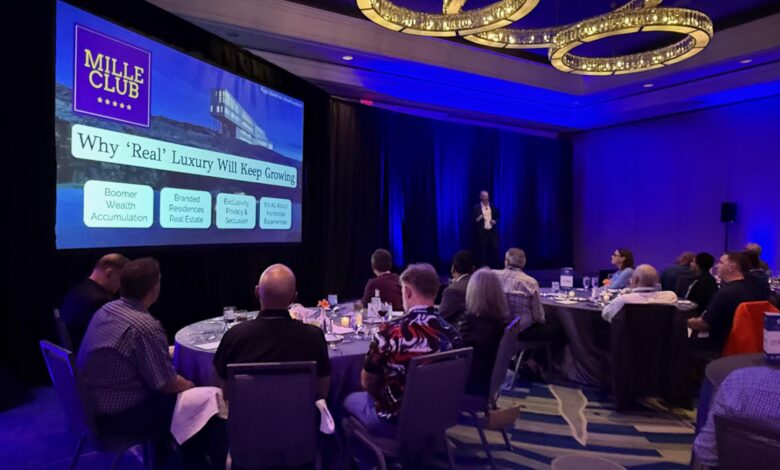
The Rise of Ultra-Luxury Hotels: Trends and Insights from Adam Mogelonsky’s BITAC Keynote Address
By Gavin Fraser | December 5, 2024
In the world of hospitality, the ultra-luxury segment is undergoing a radical transformation. Adam Mogelonsky, Partner at Hotel Mogel Consulting Ltd., recently shared valuable insights at the recent BITAC Owners Fall event, shedding light on the growing trend of luxury hotels charging over $1,000 per night. For example, The Mille Club (with “mille” referring to the Italian word for 1,000), is attracting a more affluent and discerning guest. Adam’s keynote explored the key trends driving this evolution, providing hoteliers with a roadmap for adapting to the changing luxury landscape.
The Evolution of “Real Luxury”
As Adam explained, the term “luxury” is being stretched and, in some cases, diluted. With the advent of AI tools like ChatGPT that can generate slick marketing descriptions of luxury experiences, it’s becoming harder for consumers to distinguish true luxury from the overused term itself. For today’s wealthy consumers, the price tag has become the most reliable indicator of authenticity. When a hotel charges $2,000 per night, guests have confidence in the luxury it promises, but anything lower can lead to skepticism about whether the experience truly matches the price.
Several factors are contributing to the rise in ultra-luxury properties. One major driver is the wealth of the baby boomer generation. With more boomers retiring and living off lucrative retirement funds, this group is eager to spend on exclusive, high-end experiences. Meanwhile, the trend of branded residences is reshaping the hospitality industry. High-end hotel brands are expanding into luxury real estate, offering branded apartments or residences that allow hotels to offset the significant capital costs of new developments.
Hotels are also leaning into the demand for exclusivity and privacy. In an increasingly noisy and connected world, guests are seeking seclusion—small, intimate properties where they can escape the digital distractions of everyday life. Whether it’s a boutique hotel with just 40 rooms or a remote retreat, the desire for privacy is pushing prices higher.
At the same time, the experience economy continues to dominate. Consumers are no longer just paying for a bed and a room—they’re paying for an experience that transcends traditional hotel offerings. Adam points to the ongoing Taylor Swift concert phenomenon as a prime example of this shift: people are willing to spend astronomical amounts for an experience they can’t get anywhere else, despite the fact that the content is readily available on platforms like YouTube.
Tapping into History and Storytelling
One of the most powerful ways to elevate a luxury hotel’s appeal is by embracing history. Adam used the iconic Raffles Singapore as a case study, a property that integrates its rich colonial history into the very fabric of its brand. The hotel doesn’t just offer guests a bed for the night; it offers them a chance to connect with a piece of history. The Singapore Sling, for example, was created there during a time when it was considered improper for women to drink alcohol in public. By weaving such rich backstories into the guest experience, Raffles has successfully transformed its property into a living narrative.
Hotels can take a similar approach by reflecting on their own histories or tapping into the cultural heritage of their locations. Whether it’s through storytelling, preserved architecture, or curated experiences, embracing history adds depth and meaning to the luxury experience, giving guests something truly unique and memorable.
Sustainability as a Selling Point
Sustainability is no longer just a buzzword—it’s a core value for luxury travelers. Adam highlights properties like Six Senses Rome, where biophilic design and sustainable practices are not just an afterthought but integral parts of the hotel’s identity. These efforts extend to sourcing local and recyclable materials and creating a design that aligns with environmental responsibility. The demand for sustainability is growing, especially among eco-conscious luxury travelers who expect more from the brands they support.
As Adam points out, sustainability should not be treated as a checklist item. Hotels should look for ways to market their green efforts as a defining feature, distinguishing themselves from competitors and generating earned media through positive press coverage. Embracing sustainability can also offer financial benefits, such as savings on energy costs and access to renewable energy credits.
The Rise of Branded Residences
Branded residences are becoming a key part of the luxury hotel business model. With the high costs of building new properties, luxury hotel brands are turning to branded residences as a way to balance their capital needs. By selling high-end apartments or villas, they can offset construction costs, reduce debt, and still maintain their luxury image. This trend is not limited to the ultra-luxury segment either—branded residences are starting to appear in four- and even three-star properties.
The branded residence model allows hoteliers to tap into a different market, attracting affluent buyers who may not be interested in a hotel stay but are eager to invest in a luxury property. By offering a seamless combination of hotel amenities and private ownership, this model appeals to both short-term visitors and long-term residents, enhancing overall revenue potential for hotel owners.
Multi-Generational Travel
While family travel is not a new trend, multi-generational travel is on the rise, especially as wealthy baby boomers look to spend quality time with their children and grandchildren. Adam points to a luxury property in Saint Lucia that caters specifically to families with large, multi-room villas that can accommodate multiple generations. These properties allow families to connect while still enjoying private, exclusive space and top-tier services.
Adam stressed, the key to attracting multi-generational groups is flexibility. Hotels should consider designing rooms and facilities that cater to large groups, as well as offering personalized services that can help families of all sizes enjoy a seamless, luxurious experience.
Dynamic Meetings and Events
Dynamic meetings and events have become essential for generating additional revenue. Hotels are reconfiguring their event spaces to allow for multiple uses, increasing their ability to capture a variety of revenue streams. Adam used Andaz Mexico City as an example of a hotel that offers flexible event spaces, such as its rooftop bar, which can host weddings, corporate events, and even breakfast gatherings.
Hotels can also increase their revenue by offering exclusive partnerships and events. For instance, by teaming up with local cultural institutions like the Biblioteca Ambrosiana in Milan, hotels can offer after-hours private tours to their guests—an experience that adds unique value and exclusivity to their stay.
F&B as an Experiential Offering
Food and beverage (F&B) are increasingly becoming a defining feature of the luxury hotel experience. Hotels like Brush Creek Ranch in Wyoming are taking it to the next level by offering guests the opportunity to engage in activities like ice cream making, cheese production, and on-site farming. This concept of experiential dining creates an immersive connection between guests, the land, and the food they consume.
Additionally, regenerative cuisine—a term used to describe farming practices that improve soil health—is gaining traction. Hotels are sourcing ingredients from on-site farms or nearby regenerative agriculture projects, offering guests a deeper connection to the environment while providing fresh, high-quality meals.
Wellness: From Sleep to Longevity
As luxury travelers become more health-conscious, wellness has evolved from a niche offering to a core element of the luxury hotel experience. Adam discussed how hotels are introducing sleep-focused rooms, designed to promote optimal rest with features like soundproofing, blackout curtains, and low-light settings. The importance of sleep for cognition and overall health is now widely recognized, and hotels are catering to this demand with purpose-built accommodations.
On a more advanced level, hotels are beginning to offer longevity treatments, integrating elements of preventative medicine and wellness into the guest experience. These offerings, which can range from diagnostic testing to tailored recovery plans, are part of a growing trend where hotels act as health sanctuaries, offering not only relaxation but a roadmap to healthier living.
The Luxury Hotel of Tomorrow
The ultra-luxury hotel segment is evolving rapidly, and as Adam’s keynote underscored, it’s about much more than just providing a high price tag. The hotels that will thrive in this new era are those that embrace a combination of exclusivity, sustainability, history, and immersive experiences. As the market shifts towards experiences that engage the senses, enrich lives, and provide meaningful connections, hoteliers must innovate continuously to stay ahead.
For those willing to adapt to these emerging trends, the future of ultra-luxury hospitality is bright—offering not just a place to stay, but a transformative experience that guests will treasure for years to come.






Get involved!
Comments